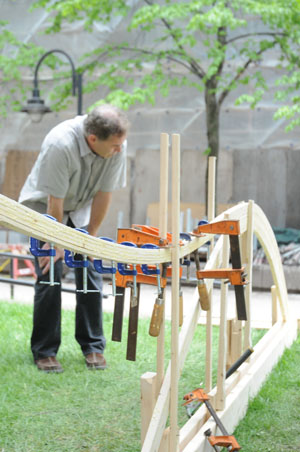Friday afternoon, fourth-year Environmental Design students will face inevitable failure โ and thatโs perfectly ok.
A longstanding tradition at the School of Architecture, โStructures Weekโ began last Saturday and concludes this Friday, with students collaborating on scaled structures that are then tested to their breaking point. Each of the five structures will, eventually, fail; the question is, which will hold together the longest?
The competition, led by Dal grad Peter Braithwaite and guest engineer William Loasby of Fast and Epp Structural Engineers, begins with students submitting models of their current design projects for consideration. Instructors then identify five student designs out of the 60 or so submissions to be developed for testing on a larger scale. Some designs are chosen because of their robustness, others because of their sense of adventure. Arches, bridge structures, and traditional frame structures are all in play.
Understanding structure
Once the designs were selected, students formed groups and have been working collaboratively with Braithwaite and Loasby to build final 1:5 scale models for testing in the heavy structures lab. Structures will be judged on strength, the load they can carry in relation to the weight of the structure itself, depth of the spanning beam, quality of craft and elegance of design.
โThe goal is for students to gain a better understanding of structure and to give them an opportunity to work with their hands,โ explains Braithwaite. โUsing the heavy structures lab and guidance from Dal Engineer in Residence, Andrea Doncaster, is an excellent example of different Faculties sharing resources and working together to provide meaningful learning opportunitiesโ.
 โIโve been impressed with the attitude of the students,โ adds Loasby. โThey are all keen to learn โ confident enough to propose ideas and open enough to take suggestions.โ
โIโve been impressed with the attitude of the students,โ adds Loasby. โThey are all keen to learn โ confident enough to propose ideas and open enough to take suggestions.โ
Student David Burlockโs project is a design for paddling club build with a glue-laminated beam roof, complete with massive cantilever and tension cables.
โIt was designed with inspiration from its position near the water and the wave motion a paddle makes gliding through a stroke,โ says Burlock. Loasby explains that the paddling club design was chosen because itโs, โstructurally beautiful and has no redundancy. I love how the floor was used to hold the base of the arch to prevent spreadingโ.
Andre Knottโs design for a multipurpose community center is an example of trust under tension style construction. Looking very much like a bridge, it uses cables in place of select wooden members, demonstrating understanding of the principles of compression and tension. โThis has been a practical way of being creative,โ says Knott. โWe have to think of how the structure is actually going to be built and how strong it will be. Itโs the closest we get to the real world in our studies.โ
Ready for destruction ย
Todayโs construction materials and techniques are so advanced that there is very little that cannot be constructed, so what tends to guide design toward more predictable solutions are two obvious factors: time and budget. With a tight Friday deadline and the need to use only available materials, this is another way the assignment resembles real life.
Friday afternoon, the structures will be loaded with weight to the point of failure. Will the innovative and elegant be able to compete with the traditional and well crafted? Come to the structures lab and find out!
Structures Week Design Competition
Friday June 12th, 2 p.m.
Heavy Structures Lab, Civil Engineering, Sexton Campus

